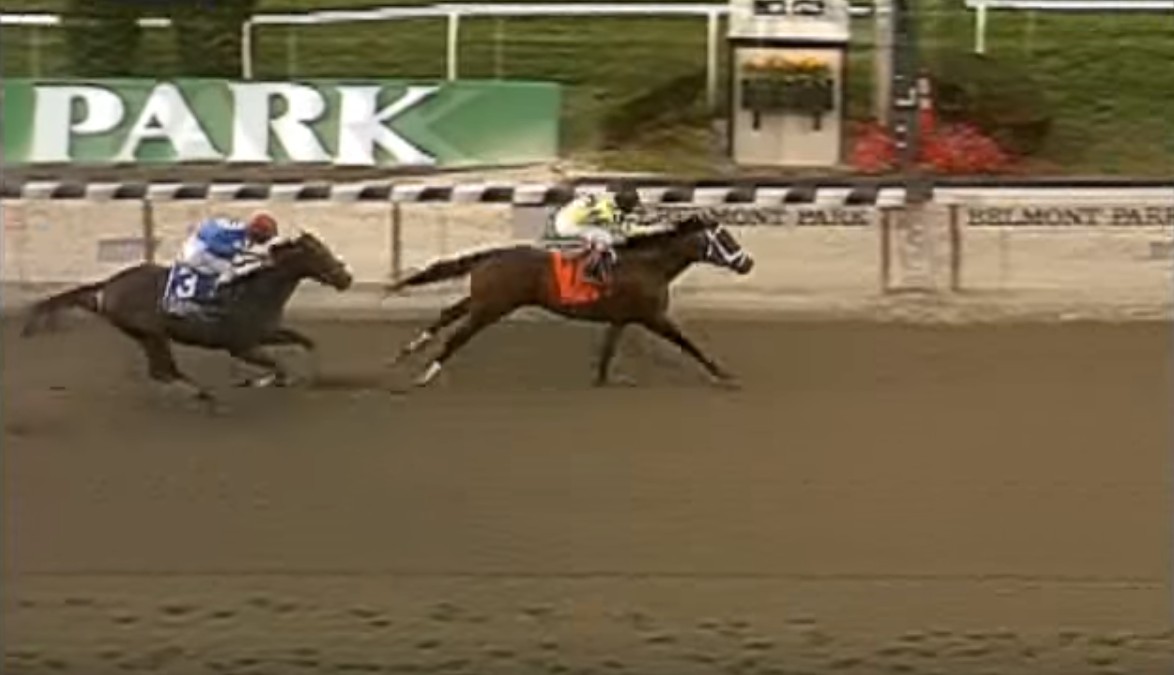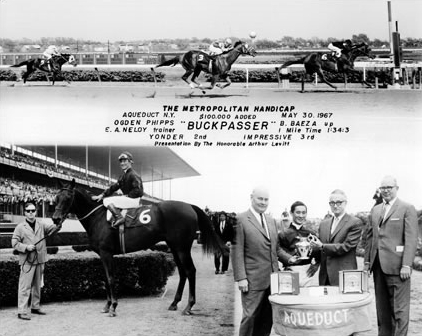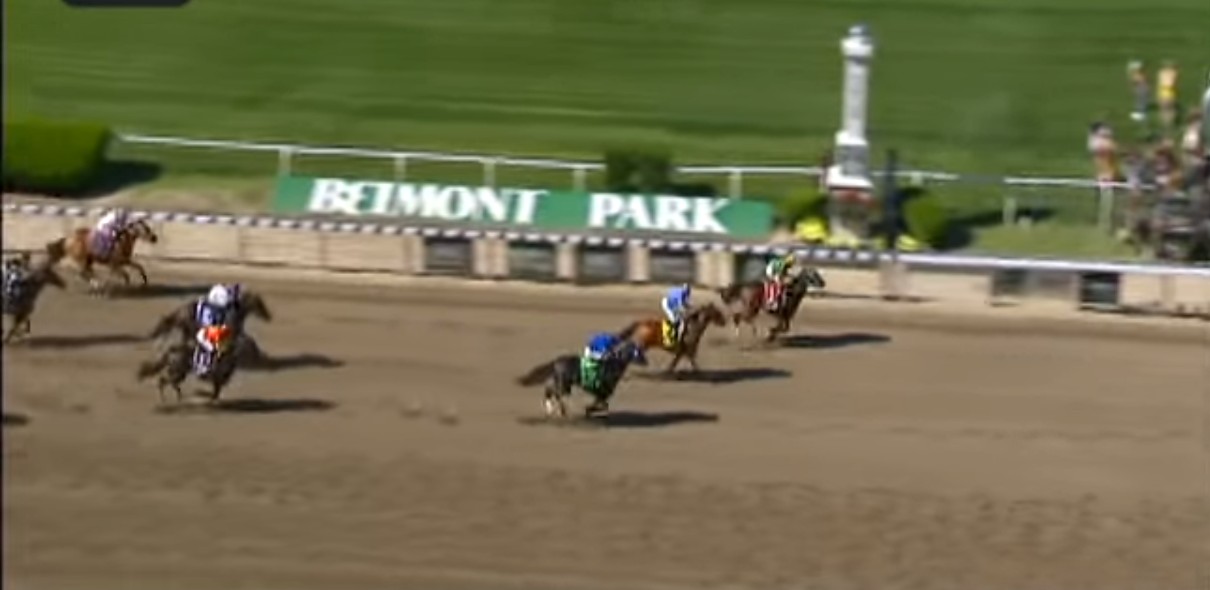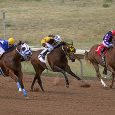
Quality Road winning the 2010 Metropolitan Handicap.
There’s an old adage or saying or cliche in racing about horses known as milers eventually becoming top stallions. Unfortunately no in-depth Google search can come up with exactly who said it first — and when (theories seem to bounce from John Nerud to John Gaines and even Bobby Frankel) — but races like the Metropolitan Handicap seem to prove the theory and prove it beyond any reasonable doubt.
Depending on perspective, the saying either goes: “great milers make good stallions” or “good milers make great stallions” and it doesn’t take a pedigree expert to know that the Met Mile absolutely lives up to both. It is quite simply a sire-making race.
The Met Mile, which has been contested as a Grade I every year since the North American grading system was implemented in 1973, is the first leg of what was known as the New York Handicap Triple and used to be followed on the calendar by the Brooklyn Handicap and Suburban Handicap. Only four horses in history completed the sweep — Whisk Broom II (1913), Tom Fool (1953), the mighty Kelso (1961) and Fit to Fight (1984). Now, with the Met Mile and the Brooklyn Run on the same day, the feat isn’t likely to be achieved again anytime soon, but it used to be a coveted crown to wear for older handicap stars.
First run in 1891, the Met Mile boats an impressive list of winners regardless of post-race careers in the breeding shed. The list of some of the standout names to have captured the one-mile feature consists of champions, classic winners, Horses of the Year and eventual Hall of Famers including the ill-fated Sysonby, two-time winner Equipoise, the filly Galorette, three-time winner Devil Diver, Stymie, Gallant Man, Carry Back, Gun Bow, the great two-time winner Forego, Criminal Type, Wild Rush, Aldebaran and most recently Palace Malice and Honor Code.
But when it comes to winners and their eventual accomplishments in the thoroughbred stud book, it’s as if the Met Mile stamps the coveted E Ticket to bloodstock immortality, especially over the past 60 years or so. Tom Fool, an eventual Hall of Famer, won the race in 1953 and in his post-running days he was always a solid stallion and was represented by Kentucky Derby and Preakness Stakes winner Tim Tam, as well as fellow Hall of Famer Buckpasser (more on Buckpasser in a minute).
The winner of the Met Mile in 1954 was dual classic winner and Hall of Famer Native Dancer, who won the Preakness and Belmont after his runner-up finish in the Derby. His sire record is nothing short of outstanding, boasting Kauai King, Dancer’s Image and Raise a Native as his most notable offspring. He is also the grandsire of the late leading sire Mr. Prospector.
Exceptional broodmare sire Gallant Man won the Met Mile in 1958, while 1959’s winner Sword Dancer would eventually be represented by dual classic winner Damascus, who himself would be honored by top runners and sires Private Account, Desert Wine, Ogygian and Time for a Change.
Olden Times won in 1964 and was a top sire most of his life. At one time the Rex Ellsworth-owned runner stood for $30k, which was among the highest stud fees in the late 1960s (comparable to a $200K stud fee today).
Now back to Buckpasser. He won the Met Mile in 1967 before going on to a very impressive stallion career. The five-time Eclipse winner saw many of his progeny go on to tremendous careers as both racehorses and, eventually, breeding stock, including La Prevoyante, L’Enjoleur, Silver Buck and more. He’s probably even better known as a broodmare sire, having been represented by Broodmares of the Year Toll Booth and Relaxing, the latter being the dam of classic winner Easy Goer. He is also defined by his daughters becoming the dams of Woodman, Touch Gold, With Approval, El Gran Señor, Miswaki and Slew o’Gold.

Photo of Buckpasser winning the 1967 Met Mile (via www.jockeysite.com).
In Reality took home the Met Mile trophy in 1968 and eventually sired notable names Desert Vixen, Smile and Known Fact, and he is also broodmare sire to Broodmare of the Year Toussaud and Meadow Star. Cox’s Ridge (1978) was represented by Life’s Magic, Little Missouri (sire of classic winner Prairie Bayou), Vanlandingham, Cardmania and Sultry Song as a sire.
One of the better stallions in the last 35 years was 1981 Met Mile winner Fappiano. Among his most notable sons are Derby winner and Horse of the Year Unbridled, Quiet American, Rubiano, Cahill Road, Defensive Play and Tasso. Unbridled is by far his most successful son and was a top sire himself and sired at least one winner in all three Triple Crown races (Grindstone, 1996 Derby; Red Bullet, 2000 Preakness; and Empire Maker, 2003 Belmont.)
In 1987 and 1988, Gulch emerged victorious in the Met Mile and before he was pensioned from stallion duty at Lane’s End in 2009 was represented by more than 76 stakes winners, including 1994 Derby winner Thunder Gulch and Court Vision, Wallenda, The Cliff’s Edge, Torrential and Japanese standout Eagle Cafe.
One of the most successful sires in California history is In Excess, who began his career in his home country of Ireland before being imported to California in the early 1990s. He was at one time the all-time leading sire in progeny earnings in the Golden State and saw his son, Indian Charlie, finish third in the Kentucky Derby. Other top runners by In Excess include Notional, Romance is Diane, Musical Romance and Excessivepleasure.
Holy Bull was the favorite heading into the 1994 Kentucky Derby and though he finished 12th of 14 that day, he’d more than make up for it the rest of the year en route to a Horse of the Year title and his strong second half of the year began with his victory in the Met Mile. Now a 25-year-old pensioner at Darley in Kentucky, the gray son of Great Above has had an above average career at stud, siring many good horses like 2005 Derby winner Giacomo and Grade I winners Macho Uno and Confessional.

Palace Malice capturing the 2014 Met Mile.
Langfuhr, 1997’s winner, sired Wando, Lawyer Ron and Imperialism, while 2004 Horse of the Year and 2005 Met Mile hero Ghostzapper has been represented by a multitude of graded winners, including Za Approval, Moreno, Judy the Beauty and Go Maggie Go, the latter who is set to run in the Acorn Stakes on the Belmont Stakes undercard Saturday. Divine Park won in 2008 and his most notable progeny to date is Breeders’ Cup winner Lady Eli, who is prepping for a return to action after successfully battling back from laminitis last year.
Quality Road, the 2010 Met Mile hero, was 2015’s top third-crop sire and has had a handful of good stakes winners so far in his young stallion career, including Met Mile challenger Blofeld this year. The 2012 hero Shakleford has so far as a freshman sire been represented by three winners from three starters, so he’s clearly off to a great start.
While it can be argued that most Grade I races over the past century have had a hand in producing successful stallions, clearly the Met Mile ranks up there in overall success, especially in terms of classic winners. This year, 13 will head postward in the 123rd running, which carries a purse of $1.25 million, and the connections of each one will look to solidify the status of their charges as good milers and, eventually, standout sires.
The views and opinions expressed herein are those of the author and do not necessarily state or reflect those of US Racing.




